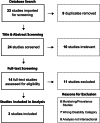Missing from the Narrative: A Seven-Decade Scoping Review of the Inclusion of Black Autistic Women and Girls in Autism Research
- PMID: 36605161
- PMCID: PMC9745006
- DOI: 10.1007/s40617-021-00654-9
Missing from the Narrative: A Seven-Decade Scoping Review of the Inclusion of Black Autistic Women and Girls in Autism Research
Abstract
The intersectional experiences of Black autistic women and girls (BAWG) are missing from medical and educational research on autism spectrum disorder (ASD). Understanding the intersectional experiences of BAWG is important due to the rising prevalence of autism in Black children and girls (Centers for Disease Control and Prevention (CDC), 2020) and the concurrent lack of availability of culturally relevant autism-related interventions (Maenner et al., 2020; West et al., 2016). Intersectionality is the study of the overlapping discrimination produced by systems of oppression (Collins, 2019; Crenshaw, 1989, 1991) and allows the researcher to simultaneously address race and disability in special education (Artiles, 2013). In this scoping review, the authors used the PRISMA-ScR checklist (Tricco et al., 2018) and Arskey and O'Malley's (2005) framework to investigate the degree to which autism-related research (ARR) has included the intersectional experiences of BAWG. Utilizing narrative synthesis, strengths and gaps across the current body of literature are identified in order to set new directions for intersectional ARR. Overall, the authors found that across a 77-year period, three studies foregrounded BAWG and none addressed intersectionality as measured through criteria advanced by García and Ortiz (2013). These results reveal the scholarly neglect BAWG face in ARR, discourse, policy, and practice. A future agenda including research, practice, and policy priorities is identified and discussed.
Keywords: Autism; Black; Gender; Girl; Intersectionality; Race; Scoping review; Woman.
© Association for Behavior Analysis International 2021.
Conflict of interest statement
Conflicts of InterestThe authors declare that they have no conflict of interest
Figures
References
-
- Adams DL, Erevelles N. Shadow play: DisCrit, dis/respectability, and carceral logics. In: Connor DJ, Ferri BA, Annamma SA, editors. DisCrit: Disability studies and critical race theory in education. Teachers College Press; 2016. pp. 131–144.
-
- American Psychiatric Association . Diagnostic and statistical manual of mental disorders. 5 2013.
-
- Annamma SA. The pedagogy of pathologization: Dis/abled girls of color in the school-prison nexus. Routledge; 2017.
-
- Annamma SA, Connor DJ, Ferri BA. Dis/ability critical race studies (DisCrit): Theorizing at the intersections of race and dis/ability. In: Connor DJ, Ferri BA, Annamma SA, editors. DisCrit: Disability studies and critical race theory in education. Teachers College Press; 2016. pp. 9–32.
-
- Annamma SA, Anyon Y, Joseph NM, Farrar J, Greer E, Downing B, Simmons J. Black girls and school discipline: The complexities of being overrepresented and understudied. Urban Education. 2019;54(2):211–242. doi: 10.1177/0042085916646610. - DOI
Publication types
LinkOut - more resources
Full Text Sources



